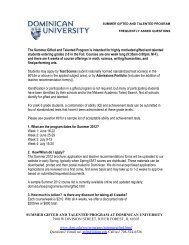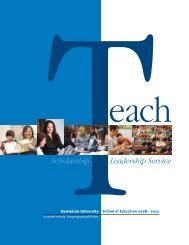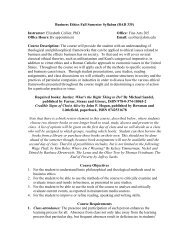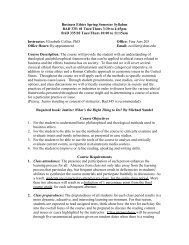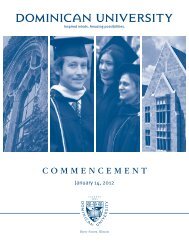6 2 - Dominican University
6 2 - Dominican University
6 2 - Dominican University
You also want an ePaper? Increase the reach of your titles
YUMPU automatically turns print PDFs into web optimized ePapers that Google loves.
All institutional records and special collections materials –<br />
even the fragile and delicate 14th and 15th century documents<br />
and Civil War collection – are available to faculty and students,<br />
as well as visitors to the archives for education and research. It’s<br />
this commitment on behalf of the library and the university that<br />
makes the collection so valuable – and not just monetarily. Much<br />
of the information can be accessed from the archives website at<br />
www.domweb.dom.edu/library/archives/archive.html.<br />
“There are two types of practice – one is to protect materials from the<br />
people, and the other is to protect materials for the people. Through<br />
the library and GSLIS, there is an active interest in the preservation<br />
and conservation courses and seeing the materials used. We make<br />
them available for people to enjoy,” says James Twomey, adjunct<br />
faculty member, Graduate School of Library and Information<br />
Sciences. Twomey – an expert in preserving and restoring antique<br />
books, documents and maps – has been teaching <strong>Dominican</strong><br />
graduate students in library science since 2004. Twomey is also<br />
working with the archivists at the Sinsinawa Mound in Wisconsin<br />
on preserving the many original volumes and records of Fr. Samuel<br />
Mazzuchelli, founder of the Sinsinawa <strong>Dominican</strong> Sisters.<br />
“<strong>Dominican</strong> <strong>University</strong> has an amazing collection of materials,”<br />
Twomey says. “There are many first editions and representatives of<br />
every major printer demonstrating innovations in type, printing and<br />
illustration. So clearly there is a focus to the collection, and whoever<br />
purchased or acquired elements of the collection knew what<br />
he/she was doing.”<br />
In addition to the countless Rosary College/<strong>Dominican</strong> records and<br />
materials, some of the most prized materials in the archives include a<br />
a French, hand-written Christian journal from the late 1600s; personal<br />
letters written by Studs Terkel, Susan B. Anthony and Jefferson<br />
Davis; original testimony documents from the Spanish Inquisition;<br />
papal bulls and letters; a suffragette letter; Civil War-era documents<br />
and ephemera; and books on Irish personalities and Irish history.<br />
Though the inventory and cataloging process is an all-consuming<br />
task, under Twomey’s tutelage, Szegedi is also undertaking many of<br />
the restoration and preservation tasks himself. “The single most<br />
FEATURE<br />
important step in preservation and conservation is to make the paper<br />
stable, so our philosophy is to slow down, stop or reverse the aging<br />
process using safe chemicals to de-acidify the paper,” Twomey<br />
explains. “We then try to heal the problem, whether it is torn paper<br />
or separated pages, and then we create a protective box for the<br />
document or book.”<br />
Preserving history – in all its forms – is a priority not only for the<br />
archives and Rebecca Crown Library, but also within the Graduate<br />
School of Library and Information Science where students can pursue an<br />
emphasis in archival studies. In addition to preservation, conservation<br />
and archiving classes, <strong>Dominican</strong> is seeking to carve a niche for itself<br />
in the area of cultural heritage informatics, and in fact last spring,<br />
sponsored an archives and cultural heritage symposium for Chicagoarea<br />
archivists and cultural heritage specialists. According to Cecilia<br />
Salvatore, PhD, associate professor, and cultural heritage informatics<br />
scholar and researcher, GSLIS students are collaborating with museums<br />
and centers, including the national McGreal Center for <strong>Dominican</strong><br />
Historical Studies, located on the <strong>Dominican</strong> <strong>University</strong> campus.<br />
“Our students can gain valuable practical experience working with<br />
organizations in assessing their cultural heritage collections, including<br />
recorded oral histories, museum and cultural artifacts, recorded<br />
performances and rituals, etc.,” Salvatore says. “The collaboration has<br />
been a fruitful and positive experience for all.” Salvatore recently<br />
received the Parsons Fund Award from the American Folklife<br />
Center of the Library of Congress to support her work to identify<br />
and evaluate the library’s institutionwide assets pertaining to the<br />
culture and history of Micronesia. In addition, Salvatore is a project<br />
consultant on behalf of the Institute of Museum and Library Studies<br />
working with the Commonwealth of the Northern Mariana Islands in<br />
the South Pacific, assessing their cultural heritage collections.<br />
Working together with the expert faculty and with the assistance of<br />
several volunteer workers, Szegedi’s sights are focused on achieving<br />
the ultimate goals of accessibility and awareness. “Our job is to create<br />
tools to ensure that these amazing materials are available to everyone<br />
for generations to come.”<br />
Fall 2010 <strong>Dominican</strong> <strong>University</strong> Magazine<br />
13



